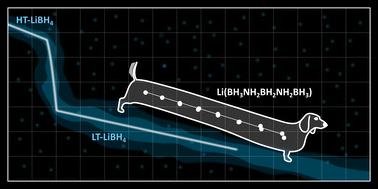Reinvestigation of the ionic conductivity of a layered Li(BH3NH2BH2NH2BH3) salt
IF 5.3
2区 材料科学
Q2 MATERIALS SCIENCE, MULTIDISCIPLINARY
引用次数: 0
Abstract
We reinvestigated the ionic conductivity of lithium ions for Li(BH3NH2BH2NH2BH3), an ammonia borane derivative. The observed conductivity (4.0 × 10−6 S cm−1 at 65 °C) was found to be over four orders of magnitude higher than the value reported previously at 70 °C for this compound. Since very slow thermal decomposition of Li(BH3NH2BH2NH2BH3) progresses already below 100 °C, the previous results reported for 70–130 °C most likely correspond to decomposed samples. The activation energy for the lithium conductivity of polycrystalline layered Li(BH3NH2BH2NH2BH3) (57 kJ mol−1) resembles that of powdered Li3N (59 kJ mol−1), suggesting a similar mechanism of lithium diffusion in both materials.

层状锂(BH3NH2BH2NH2BH3)盐离子导电性的再研究
我们重新研究了氨硼烷衍生物 Li(BH3NH2BH2NH2BH3) 的锂离子离子电导率。观察到的电导率(65 °C 时为 4.0 × 10-6 S cm-1)比之前报告的该化合物 70 °C 时的电导率高出四个数量级。由于 Li(BH3NH2BH2NH2BH3) 的热分解速度非常缓慢,低于 100 °C时就已经开始分解,因此之前报道的 70-130 °C 时的结果很可能与分解的样品相对应。多晶层状 Li(BH3NH2BH2NH2BH3)的锂传导活化能(57 kJ mol-1)与粉末状 Li3N 的活化能(59 kJ mol-1)相似,这表明这两种材料的锂扩散机制相似。
本文章由计算机程序翻译,如有差异,请以英文原文为准。
求助全文
约1分钟内获得全文
求助全文
来源期刊

ACS Applied Nano Materials
Multiple-
CiteScore
8.30
自引率
3.40%
发文量
1601
期刊介绍:
ACS Applied Nano Materials is an interdisciplinary journal publishing original research covering all aspects of engineering, chemistry, physics and biology relevant to applications of nanomaterials. The journal is devoted to reports of new and original experimental and theoretical research of an applied nature that integrate knowledge in the areas of materials, engineering, physics, bioscience, and chemistry into important applications of nanomaterials.
 求助内容:
求助内容: 应助结果提醒方式:
应助结果提醒方式:


